您好,登錄后才能下訂單哦!
您好,登錄后才能下訂單哦!
本篇內容介紹了“怎么通過Heketi管理GlusterFS為K8S集群提供持久化存儲”的有關知識,在實際案例的操作過程中,不少人都會遇到這樣的困境,接下來就讓小編帶領大家學習一下如何處理這些情況吧!希望大家仔細閱讀,能夠學有所成!
參考文檔:
Github project:https://github.com/heketi/heketi
MANAGING VOLUMES USING HEKETI:https://access.redhat.com/documentation/en-us/red_hat_gluster_storage/3.3/html/administration_guide/ch05s02
StorageClass:https://kubernetes.io/docs/concepts/storage/storage-classes/
StorageClass(中文):https://k8smeetup.github.io/docs/concepts/storage/storage-classes/
Dynamic Volume Provisioning:https://kubernetes.io/docs/concepts/storage/dynamic-provisioning/
nfs- provisioner:https://github.com/kubernetes-incubator/external-storage/tree/master/nfs
Heketi是一個提供RESTful API管理GlusterFS卷的框架,便于管理員對GlusterFS進行操作:
可以用于管理GlusterFS卷的生命周期;
能夠在OpenStack,Kubernetes,Openshift等云平臺上實現動態存儲資源供應(動態在GlusterFS集群內選擇bricks構建volume);
支持GlusterFS多集群管理。
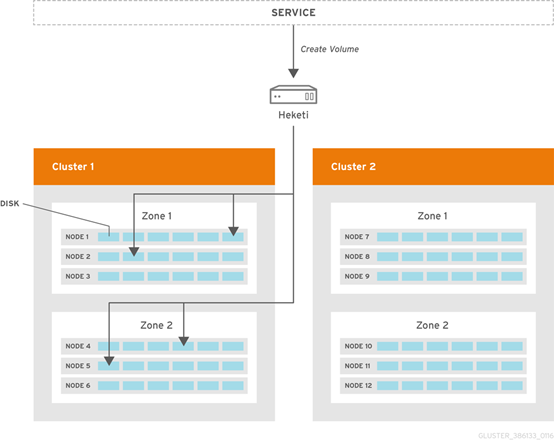
Heketi支持GlusterFS多集群管理;
在集群中通過zone區分故障域。
Kubernetes與GlusterFS集群已提前部署完成,請參考:
Kubernetes:https://www.cnblogs.com/netonline/tag/kubernetes/
GlusterFS:https://www.cnblogs.com/netonline/p/9102004.html
注意:GlusterFS只需要安裝并啟動即可,不必組建受信存儲池(trusted storage pools)
Hostname | IP | Remark |
kubenode1 | 172.30.200.21 | |
kubenode2 | 172.30.200.22 | |
kubenode3 | 172.30.200.23 | |
heketi | 172.30.200.80 | selinux disabled |
glusterfs01 | 172.30.200.81 | |
glusterfs02 | 172.30.200.82 | |
glusterfs03 | 172.30.200.83 |
# 設置iptables,heketi默認以tcp8080端口提供RESTful API服務; [root@heketi ~]# vim /etc/sysconfig/iptables -A INPUT -p tcp -m state --state NEW -m tcp --dport 8080 -j ACCEPT [root@heketi ~]# service iptables restart
# 添加gluster yum源,默認yum源中無相關package; # heketi:heketi服務; # heketi-client:heketi客戶端/命令行工具 [root@heketi ~]# yum install -y centos-release-gluster [root@heketi ~]# yum install -y heketi heketi-client
# 注意紅色字體是修改部分[root@heketi ~]# vim /etc/heketi/heketi.json
{
# 默認端口tcp8080
"_port_comment": "Heketi Server Port Number",
"port": "8080",
# 默認值false,不需要認證
"_use_auth": "Enable JWT authorization. Please enable for deployment",
"use_auth": true,
"_jwt": "Private keys for access",
"jwt": {
"_admin": "Admin has access to all APIs",
"admin": {
"key": "admin@123"
},
"_user": "User only has access to /volumes endpoint",
"user": {
"key": "user@123"
}
},
"_glusterfs_comment": "GlusterFS Configuration",
"glusterfs": {
"_executor_comment": [
"Execute plugin. Possible choices: mock, ssh",
"mock: This setting is used for testing and development.",
">ssh",
"_sshexec_comment": "SSH username and private key file information",
"sshexec": {
"keyfile": "/etc/heketi/heketi_key",
"user": "root",
"port": "22",
"fstab": "/etc/fstab"
},
"_kubeexec_comment": "Kubernetes configuration",
"kubeexec": {
"host" :"https://kubernetes.host:8443",
"cert" : "/path/to/crt.file",
"insecure": false,
"user": "kubernetes username",
"password": "password for kubernetes user",
"namespace": "OpenShift project or Kubernetes namespace",
"fstab": "Optional: Specify fstab file on node. Default is /etc/fstab"
},
"_db_comment": "Database file name",
"db": "/var/lib/heketi/heketi.db",
"_loglevel_comment": [
"Set log level. Choices are:",
" none, critical, error, warning, info, debug",
"Default is warning"
],
# 默認設置為debug,不設置時的默認值即是warning;
# 日志信息輸出在/var/log/message
"loglevel" : "warning"
}
}# 選擇ssh執行器,heketi服務器需要免密登陸GlusterFS集群的各節點; # -t:秘鑰類型; # -q:安靜模式; # -f:指定生成秘鑰的目錄與名字,注意與heketi.json的ssh執行器中"keyfile"值一致; # -N:秘鑰密碼,””即為空 [root@heketi ~]# ssh-keygen -t rsa -q -f /etc/heketi/heketi_key -N "" # heketi服務由heketi用戶啟動,heketi用戶需要有新生成key的讀賦權,否則服務無法啟動 [root@heketi ~]# chown heketi:heketi /etc/heketi/heketi_key # 分發公鑰; # -i:指定公鑰 [root@heketi ~]# ssh-copy-id -i /etc/heketi/heketi_key.pub root@172.30.200.81 [root@heketi ~]# ssh-copy-id -i /etc/heketi/heketi_key.pub root@172.30.200.82 [root@heketi ~]# ssh-copy-id -i /etc/heketi/heketi_key.pub root@172.30.200.83
# 通過yum安裝heketi,默認的systemd文件有1處錯誤; # /usr/lib/systemd/system/heketi.service文件的”-config=/etc/heketi/heketi.json”應該修改為”--config=/etc/heketi/heketi.json”; # 否則啟動時報”Error: unknown shorthand flag: 'c' in -config=/etc/heketi/heketi.json“錯,導致服務無法啟動 [root@heketi ~]# systemctl enable heketi [root@heketi ~]# systemctl restart heketi [root@heketi ~]# systemctl status heketi
# 驗證 [root@heketi ~]# curl http://localhost:8080/hello

# 通過topology.json文件定義組建GlusterFS集群;
# topology指定了層級關系:clusters-->nodes-->node/devices-->hostnames/zone;
# node/hostnames字段的manage填寫主機ip,指管理通道,在heketi服務器不能通過hostname訪問GlusterFS節點時間不能填寫hostname;
# node/hostnames字段的storage填寫主機ip,指存儲數據通道,與manage可以不一樣;
# node/zone字段指定了node所處的故障域,heketi通過跨故障域創建副本,提高數據高可用性質,如可以通過rack的不同區分zone值,創建跨機架的故障域;
# devices字段指定GlusterFS各節點的盤符(可以是多塊盤),必須是未創建文件系統的裸設備
[root@heketi ~]# vim /etc/heketi/topology.json
{
"clusters": [
{
"nodes": [
{
"node": {
"hostnames": {
"manage": [
"172.30.200.81"
],
"storage": [
"172.30.200.81"
]
},
"zone": 1
},
"devices": [
"/dev/sdb"
]
},
{
"node": {
"hostnames": {
"manage": [
"172.30.200.82"
],
"storage": [
"172.30.200.82"
]
},
"zone": 2
},
"devices": [
"/dev/sdb"
]
},
{
"node": {
"hostnames": {
"manage": [
"172.30.200.83"
],
"storage": [
"172.30.200.83"
]
},
"zone": 3
},
"devices": [
"/dev/sdb"
]
}
]
}
]
}# GlusterFS集群各節點的glusterd服務已正常啟動,但不必組建受信存儲池; # heketi-cli命令行也可手動逐層添加cluster,node,device,volume等; # “--server http://localhost:8080”:localhost執行heketi-cli時,可不指定; # ”--user admin --secret admin@123 “:heketi.json中設置了認證,執行heketi-cli時需要帶上認證信息,否則報”Error: Invalid JWT token: Unknown user”錯 [root@heketi ~]# heketi-cli --server http://localhost:8080 --user admin --secret admin@123 topology load --json=/etc/heketi/topology.json
# 查看heketi topology信息,此時volume與brick等未創建; # 通過”heketi-cli cluster info“可以查看集群相關信息; # 通過”heketi-cli node info“可以查看節點相關信息; # 通過”heketi-cli device info“可以查看device相關信息 [root@heketi ~]# heketi-cli --user admin --secret admin@123 topology info
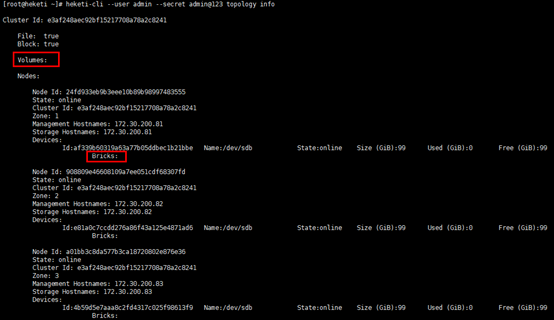
kubernetes共享存儲供應模式:
靜態模式(Static):集群管理員手工創建PV,在定義PV時需設置后端存儲的特性;
動態模式(Dynamic):集群管理員不需要手工創建PV,而是通過StorageClass的設置對后端存儲進行描述,標記為某種"類型(Class)";此時要求PVC對存儲的類型進行說明,系統將自動完成PV的創建及與PVC的綁定;PVC可以聲明Class為"",說明PVC禁止使用動態模式。
基于StorageClass的動態存儲供應整體過程如下圖所示:
集群管理員預先創建存儲類(StorageClass);
用戶創建使用存儲類的持久化存儲聲明(PVC:PersistentVolumeClaim);
存儲持久化聲明通知系統,它需要一個持久化存儲(PV: PersistentVolume);
系統讀取存儲類的信息;
系統基于存儲類的信息,在后臺自動創建PVC需要的PV;
用戶創建一個使用PVC的Pod;
Pod中的應用通過PVC進行數據的持久化;
而PVC使用PV進行數據的最終持久化處理。
# provisioner:表示存儲分配器,需要根據后端存儲的不同而變更; # reclaimPolicy: 默認即”Delete”,刪除pvc后,相應的pv及后端的volume,brick(lvm)等一起刪除;設置為”Retain”時則保留數據,需要手工處理 # resturl:heketi API服務提供的url; # restauthenabled:可選參數,默認值為”false”,heketi服務開啟認證時必須設置為”true”; # restuser:可選參數,開啟認證時設置相應用戶名; # secretNamespace:可選參數,開啟認證時可以設置為使用持久化存儲的namespace; # secretName:可選參數,開啟認證時,需要將heketi服務的認證密碼保存在secret資源中; # clusterid:可選參數,指定集群id,也可以是1個clusterid列表,格式為”id1,id2”; # volumetype:可選參數,設置卷類型及其參數,如果未分配卷類型,則有分配器決定卷類型;如”volumetype: replicate:3”表示3副本的replicate卷,”volumetype: disperse:4:2”表示disperse卷,其中‘4’是數據,’2’是冗余校驗,”volumetype: none”表示distribute卷# [root@kubenode1 ~]# mkdir -p heketi [root@kubenode1 ~]# cd heketi/ [root@kubenode1 heketi]# vim gluster-heketi-storageclass.yaml apiVersion: storage.k8s.io/v1 kind: StorageClass metadata: name: gluster-heketi-storageclass provisioner: kubernetes.io/glusterfs reclaimPolicy: Delete parameters: resturl: "http://172.30.200.80:8080" restauthenabled: "true" restuser: "admin" secretNamespace: "default" secretName: "heketi-secret" volumetype: "replicate:2" # 生成secret資源,其中”key”值需要轉換為base64編碼格式 [root@kubenode1 heketi]# echo -n "admin@123" | base64 # 注意name/namespace與storageclass資源中定義一致; # 密碼必須有“kubernetes.io/glusterfs” type [root@kubenode1 heketi]# cat heketi-secret.yaml apiVersion: v1 kind: Secret metadata: name: heketi-secret namespace: default data: # base64 encoded password. E.g.: echo -n "mypassword" | base64 key: YWRtaW5AMTIz type: kubernetes.io/glusterfs
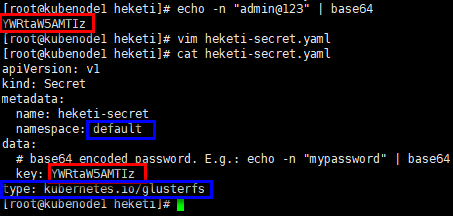
# 創建secret資源 [root@kubenode1 heketi]# kubectl create -f heketi-secret.yaml # 創建storageclass資源; # 注意:storageclass資源創建后不可變更,如修改只能刪除后重建 [root@kubenode1 heketi]# kubectl create -f gluster-heketi-storageclass.yaml
# 查看storageclass資源 [root@kubenode1 heketi]# kubectl describe storageclass gluster-heketi-storageclass

# 注意“storageClassName”的對應關系 [root@kubenode1 heketi]# vim gluster-heketi-pvc.yaml kind: PersistentVolumeClaim apiVersion: v1 metadata: name: gluster-heketi-pvc spec: storageClassName: gluster-heketi-storageclass # ReadWriteOnce:簡寫RWO,讀寫權限,且只能被單個node掛載; # ReadOnlyMany:簡寫ROX,只讀權限,允許被多個node掛載; # ReadWriteMany:簡寫RWX,讀寫權限,允許被多個node掛載; accessModes: - ReadWriteOnce resources: requests: # 注意格式,不能寫“GB” storage: 1Gi # 創建pvc資源 [root@kubenode1 heketi]# kubectl create -f gluster-heketi-pvc.yaml
# 查看PVC,狀態為”Bound”; # “Capacity”為2G,是因為同步創建meta數據 [root@kubenode1 heketi]# kubectl describe pvc gluster-heketi-pvc
# 查看PV詳細信息,除容量,引用storageclass信息,狀態,回收策略等外,同時給出GlusterFS的Endpoint與path; [root@kubenode1 heketi]# kubectl get pv [root@kubenode1 heketi]# kubectl describe pv pvc-532cb8c3-cfc6-11e8-8fde-005056bfa8ba
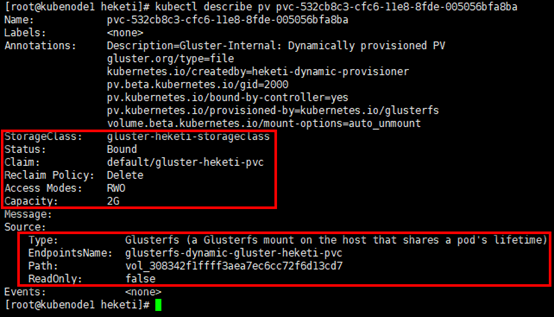
# 查看endpoints資源,可以從pv信息中獲取,固定格式:glusterfs-dynamic-PVC_NAME; # endpoints資源中指定了掛載存儲時的具體地址 [root@kubenode1 heketi]# kubectl describe endpoints glusterfs-dynamic-gluster-heketi-pvc
# volume與brick已經創建; # 主掛載點(通信)在glusterfs01節點,其余兩個節點備選; # 兩副本的情況下,glusterfs03節點并未創建brick [root@heketi ~]# heketi-cli --user admin --secret admin@123 topology info
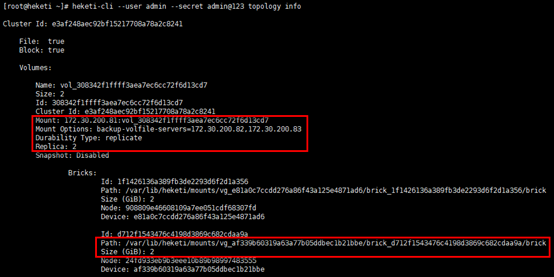
# 以glusterfs01節點為例 [root@glusterfs01 ~]# lsblk

[root@glusterfs01 ~]# df -Th
# 查看volume的具體信息:2副本的replicate卷; # 另有”vgscan”,”vgdisplay”也可查看邏輯卷組信息等 [root@glusterfs01 ~]# gluster volume list [root@glusterfs01 ~]# gluster volume info vol_308342f1ffff3aea7ec6cc72f6d13cd7

# 設置1個volume被pod引用,volume的類型為”persistentVolumeClaim” [root@kubenode1 heketi]# vim gluster-heketi-pod.yaml kind: Pod apiVersion: v1 metadata: name: gluster-heketi-pod spec: containers: - name: gluster-heketi-container image: busybox command: - sleep - "3600" volumeMounts: - name: gluster-heketi-volume mountPath: "/pv-data" readOnly: false volumes: - name: gluster-heketi-volume persistentVolumeClaim: claimName: gluster-heketi-pvc # 創建pod [root@kubenode1 heketi]# kubectl create -f gluster-heketi-pod.yaml
# 在容器的掛載目錄中創建文件 [root@kubenode1 heketi]# kubectl exec -it gluster-heketi-pod /bin/sh / # cd /pv-data /pv-data # echo "This is a file!"># 在GlusterFS節點對應掛載目錄查看創建的文件; # 掛載目錄通過”df -Th”或”lsblk”獲取 [root@glusterfs01 ~]# df -Th [root@glusterfs01 ~]# cd /var/lib/heketi/mounts/vg_af339b60319a63a77b05ddbec1b21bbe/brick_d712f1543476c4198d3869c682cdaa9a/brick/ [root@glusterfs01 brick]# ls [root@glusterfs01 brick]# cat a.txt [root@glusterfs01 brick]# cat b.txt 6. 驗證StorageClass的ReclaimPolicy# 刪除Pod應用后,再刪除pvc [root@kubenode1 heketi]# kubectl delete -f gluster-heketi-pod.yaml [root@kubenode1 heketi]# kubectl delete -f gluster-heketi-pvc.yaml # k8s資源 [root@kubenode1 heketi]# kubectl get pvc [root@kubenode1 heketi]# kubectl get pv [root@kubenode1 heketi]# kubectl get endpoints # heketi [root@heketi ~]# heketi-cli --user admin --secret admin@123 topology info # GlusterFS節點 [root@glusterfs01 ~]# lsblk [root@glusterfs01 ~]# df -Th [root@glusterfs01 ~]# gluster volume list
“怎么通過Heketi管理GlusterFS為K8S集群提供持久化存儲”的內容就介紹到這里了,感謝大家的閱讀。如果想了解更多行業相關的知識可以關注億速云網站,小編將為大家輸出更多高質量的實用文章!
免責聲明:本站發布的內容(圖片、視頻和文字)以原創、轉載和分享為主,文章觀點不代表本網站立場,如果涉及侵權請聯系站長郵箱:is@yisu.com進行舉報,并提供相關證據,一經查實,將立刻刪除涉嫌侵權內容。